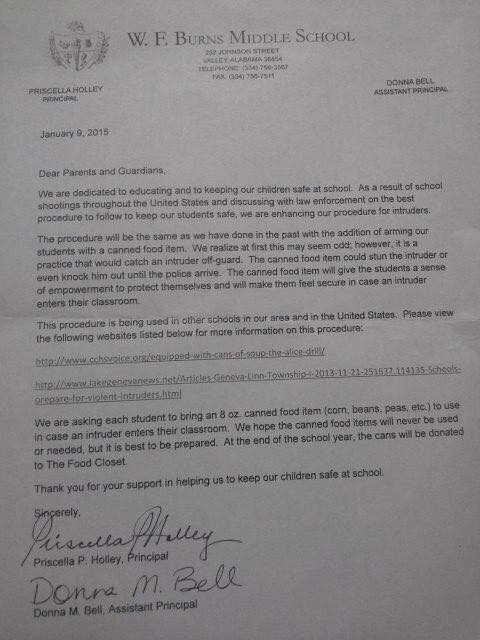
Claim: An Alabama middle school sent a letter to parents requesting canned goods to be used for defense against intruders.
Example: [Collected via e-mail, January 2015]
I'm seeing some references on facebook about a letter from a school principal asking students to bring canned food, not for a food drive, but to use in case of an intruder. The idea is that the students can throw the cans of food at an intruder and hopefully stun, disable, or even incapacitate the offender. The school is located in east Alabama and the article shows a letter on letterhead.

Origins: In January 2015, a purported middle school's letter to parents began to circulate on the Internet. The letter, dated
We are dedicated to educating and keeping our children safe at school. As a result of school shootings throughout the United States and discussing with law enforcement on the best procedure to follow to keep our students safe, we are enhancing our procedure for intruders.
The procedure will be the same as we have done in the past with the addition of arming our students with a canned food item. We realize at first this may seem odd; however, it is a practice that would catch an intruder
This procedure is being used in other schools in our area and in the United States. Please view the following websites listed below for more information on this procedure.
We are asking each student to bring an
Thank you for your support in helping us keep our children safe at school.
We confirmed the letter's authenticity with
Although he had trained for many years to have officers ready for an active shooter call, Greg asked Lisa a question he had never asked a school administrator, "What are y'all doing while the police are making their way to the school?" Lisa explained the school's protocol, which was the standard at the time, "When I find out we have an intruder, I put out a "Code Red" over the PA, the teachers get everyone in a classroom, lock the door, turn off the lights, sit in the corner and wait for the police to arrive." Greg said for the first time the abnormally high numbers of killed and wounded in the recent school shootings of the 90s made perfect
The ALICE program was created out of a husband's desire for his wife to have a better plan in case of an active shooter event. After the Columbine High School shooting, Greg Crane was a law enforcement officer in the Dallas/Ft. Worth area and his wife, Lisa, was an elementary principal. While both prepared in their professional lives for this type of tragic event, it was not until a fateful conversation around the dinner table that brought the two worlds together and created the ALICE program. Around a Christmas Eve dinner in 2001, when an announcement came across the local news of an officer being killed in the line of duty the conversation turned toward the dangers of law enforcement.
The "C" in ALICE stands for "Counter," and a page on the topic "Active Shooter Response" describes
Counter focuses on disruptive actions that create noise, movement, distance and distraction with the intent of reducing the shooter's ability to shoot accurately. Creating a dynamic environment decreases the shooter's chances of hitting a target and can provide the precious seconds needed in order to evacuate. ALICE does not endorse civilians fighting an active shooter, but when confronted directly in a Counter is about survival. It is about the last moments between a shooter and a potential victim; anything a person can to do gain control is acceptable. It is the opposite of passive response because every action taken is a proactive step towards survival.
ALICE Training does not believe that actively confronting a violent intruder is the best method for ensuring the safety of all involved, whether in a school, a hospital, a business, or a church.
The
Each science classroom is equipped with cans of soup to be thrown at the intruder in the instance that the intruder enters the classroom. Many students and teachers have thought of more creative ways to handle the situation; textbooks, chairs, calculators, and other heavy classroom materials have been suggested as possible defense equipment. English teacher Kate Fleming even suggested equipping each student with a hardcover edition of Madame Bovary. Math teacher Jeryll Kennedy even brought three filing cabinets into the classroom to barricade the doors. Teachers even went so far as to show students a secret dusty tunnel in the physics classroom, as Elaine Picard and Kevin Penucci both did. World Religions teacher Ethan Hoblitzelle encouraged a calm state of mind during these drills by allowing his students to meditate.
Also cited in the letter was ALICE training undertaken at
"If there is a shooter outside, well, what would you do if it was a fire? You wouldn't want to go out to the fire," [Linn Police Sgt. James] Bushey said. "So this is really common sense-type stuff." "If you’re going to engage somebody, if you're going to go into hands-on with them, you stay that way until the fight is over," Bushey said. This is where improvising can help save a life, and it seems to have generated some interesting self-defense techniques. Bushey said many classrooms are now keeping a collection of canned He said one classroom he entered during a drill, the teacher came to the door with a large textbook in her hand. "She had all her students behind her, and they all had books in their
[S]urviving a violent intruder event comes down to being observant, using common sense and improvising.
Last updated: 14 January 2015
